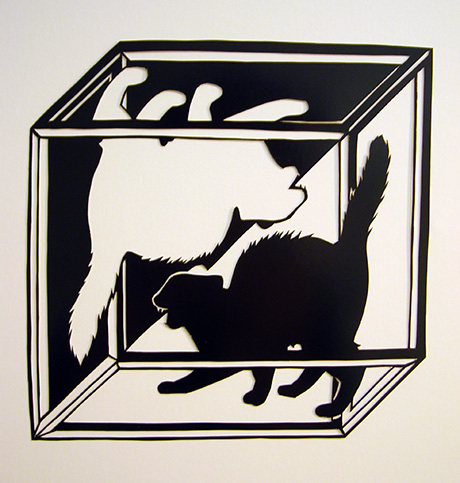| E = m c2
What was our trust, we trust not,
What was our faith, we doubt;
Whether we must or not
We may debate about.
The soul, perhaps, is a gust of gas
And wrong is a form of right-
But we know that Energy equals Mass
By the Square of the Speed of Light.
What we have known, we know not,
What we have proved, abjure.
Life is a tangled bowknot,
But one thing still is sure.
Come, little lad; come, little lass,
Your docile creed recite:
"We know that Energy equals Mass
By the Square of the Speed of Light."
Morris Bishop
The
Best of Bishop
ed. Charlotte
Putnam Reppert
Cornell
University Press, Ithaca, 1980
The Purist
I give you now Professor Twist,
A conscientious scientist.
Trustees exclaimed, "He never bungles!"
And sent him off to distant jungles.
Camped on a tropic riverside,
Once day he missed his loving bride.
She had, the guide informed him later,
Been eaten by an alligator.
Professor Twist could not but smile.
"You mean," he said, "a crocodile."
Ogden Nash
The
Fireside Book of Humorous Poetry
ed. William Cole
Simon
and Schuster, New York, 1959
Limerick
A conjecture both deep and profound
Asserts that the circle is round.
In a paper of Erdös
Written in Kurdish
A counterexample is found.
Adapted from a limerick widely
attributed to Leo Moser
|
|
Ballade of the Copenhagen Interpretation
Our colleague's pet to the box has gone,
We have armed and set the infernal device,
Now we wait, as the clock ticks on:
What is the state of our sacrifice?
Mousing in Hell amid fire and ice?
Still prowling the box with meow or purr?
Or a superposition, a sort of splice?
When does the damned collapse occur?
There's an expert here we may call upon,
An avuncular sage whom we might entice
To explain how defining "phenomenon"
Will resolve our dilemma in a trice.
"Alive or dead? Yin or yang? Snails, or spice?
It's complementarity!'' Come then, sir,
May we not ask you to be precise?
When does the damned collapse occur?
We are loath to cross our Rubicon
And a friend has a friend, not overnice,
Who will look. But what then? When our myrmidon
Returns, will we see him not once but twice?
Suspended half way between mew and mice,
A double image that seems to blur?
If he tells us his news, will that suffice?
When does the damned collapse occur?
Prince, we suspect you do not play dice—
Here to the master we defer—
Otherwise, tell us, and name your price,
When does the damned collapse occur?
E. Speer
Eminent Cosmologists
Nature and nature's laws lay hid in night.
God said, "Let Newton be!" and all was light.
It could not last: the devil howling,"Ho,
Let Einstein be!" restored the status quo.
Alexander Pope and J. C. Squire
The Faber Book of Comic Verse
ed. Michael Roberts
Faber and Faber, London, 1942.
To think that two and two are four
—To think that two and two are four
And neither five nor three
The heart of man has long been sore
And long 'tis like to be.
A. E. Housman
Stanza three of poem XXXV of Last Poems
Henry Holt, New York, 1922.
|
 The image which may have led you to these rhymes of science
is a symbolic version of the Schroedinger cat paradox, due to Jie Qi.
Here the usual box in which the cat is imprisoned is replaced by an
impossible cube.
The image which may have led you to these rhymes of science
is a symbolic version of the Schroedinger cat paradox, due to Jie Qi.
Here the usual box in which the cat is imprisoned is replaced by an
impossible cube.
 The image which may have led you to these rhymes of science
is a symbolic version of the Schroedinger cat paradox, due to Jie Qi.
Here the usual box in which the cat is imprisoned is replaced by an
impossible cube.
The image which may have led you to these rhymes of science
is a symbolic version of the Schroedinger cat paradox, due to Jie Qi.
Here the usual box in which the cat is imprisoned is replaced by an
impossible cube.